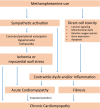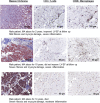Clinical Characteristics and Management of Methamphetamine-Associated Cardiomyopathy: State-of-the-Art Review
- PMID: 32468897
- PMCID: PMC7428977
- DOI: 10.1161/JAHA.120.016704
Clinical Characteristics and Management of Methamphetamine-Associated Cardiomyopathy: State-of-the-Art Review
Abstract
Methamphetamine-associated cardiomyopathy (MACM) is an increasingly recognized disease entity in the context of a rapidly spreading methamphetamine epidemic. MACM may afflict individuals with a wide range of ages and socioeconomic backgrounds. Presentations can vary greatly and may involve several complications unique to the disease. Given the public health significance of this disease, there is a relative dearth of consensus material to guide clinicians in understanding, diagnosing, and managing MACM. This review therefore aims to: (1) describe pathologic mechanisms of methamphetamine as they pertain to the development, progression, and prognosis of MACM, and the potential to recover cardiac function; (2) summarize existing data from epidemiologic studies and case series in an effort to improve recognition and diagnosis of the disease; (3) guide short- and long-term management of MACM with special attention to expected or potential sequelae of the disease; and (4) highlight pivotal unanswered questions in need of urgent investigation from a public health perspective.
Keywords: cardiomyopathy; diagnosis; heart failure; management; methamphetamine.
Figures



References
-
- Rasmussen N. Making the first anti‐depressant: amphetamine in American medicine, 1929–1950. J Hist Med Allied Sci. 2006;61:288–323. - PubMed
-
- Vearrier D, Greenberg MI, Miller SN, Okaneku JT, Haggerty DA. Methamphetamine: history, pathophysiology, adverse health effects, current trends, and hazards associated with the clandestine manufacture of methamphetamine. Dis Mon. 2012;58:38–89. - PubMed
-
- Rasmussen N. Amphetamine‐type stimulants: the early history of their medical and non‐medical uses. Int Rev Neurobiol. 2015;120:9–25. - PubMed
-
- Romanelli F, Smith KM. Clinical effects and management of methamphetamine abuse. Pharmacotherapy. 2006;26:1148–1156. - PubMed
-
- National Institute on Drug Abuse (NIDA) Epidemiologic Trends in Drug Abuse: Proceedings of the Community Epidemiology Work Group, Highlights and Executive Summary. Bethesda, MD: U.S. Department of Health and Human Services, National Institutes of Health, 2012.
Publication types
MeSH terms
Substances
LinkOut - more resources
Full Text Sources
Medical

